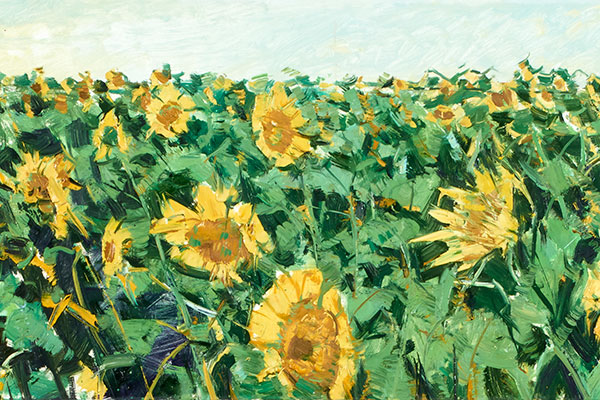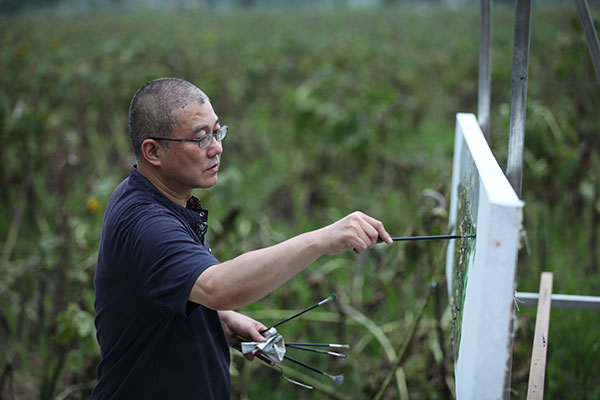
Xu Jiang is showing his paintings and sculptures of sunflowers in Shanghai. The artist says that, after focusing on the plant for 12 years, this will be his last exclusive show on sunflowers.[Photo provided to China Daily]
Xu Jiang’s canvas has had sun-flowers for more than a decade.
With their curled leaves, the artist’s flowers mostly stand firm even in poor weather conditions.
The largest retrospective show of his works, Oriental Sunflowers II, opened to the public in Shanghai on Dec 3, with about 160 paintings and large-scale sculptures.
It is his last exclusive exhibition on sunflowers, the 60-year-old artist says. He has held nearly one show a year on the theme both in China and abroad in the past few years.
“It’s hard for one to devote 12 years painting a single subject. I want to start a new phase,” says Xu, who is also the president of the China Academy of Art, a government college that has produced some of the country’s finest artists.
Xu seldom paints lonely sunflowers. His paintings have always been filled with fields of them.
“In my works, sunflowers can be seen as people, especially Chinese people. They have a lot in common-they are strong, fervent and self-sacrificing,” Xu says.
Among images of sunflowers he most remembers and has tried to capture in his artworks are: wilted sunflowers against a setting sun in Turkey’s Marmara region; snow-sprinkled sunflowers in China’s Inner Mongolia autonomous region; bunches of the flower in the Xinjiang Uygur autonomous region; and a few standing tall in the aftermath of a typhoon in East China’s Zhejiang province.
He says that when he found a sun-flower garden on a snowy day in Inner Mongolia, local farmers told him that the flower tends to improve the soil. That was when he began to attribute the “powerful” trait to the plant in his works.
Xu noticed the flower’s toughness in rural Zhejiang after a typhoon, he says.
As a fan of the NBA basketball star Kobe Bryant, Xu describes the iconic player as a “sunflower who never gives up” in the field.

Artist Xu Jiang. [Photo provided to China Daily]
Born in eastern Fujian province, Xu worked in a factory when he was 20, and later studied oil painting in college in Germany. He returned to China to teach at the China Academy of Art in 1992.
Xu was among prominent artists to attend a seminar addressed by President Xi Jinping in Beijing last year.
Xu says that he agrees with Xi’s words that art should inspire minds and cultivate taste.
“Good taste can be derived from our traditional arts. We should respect and create new things from our culture like ink-and-water paintings and tea art,” Xu adds.
He gives the example of olden-day Chinese ink painters who usually stayed at the base of a mountain for a few days while painting a picture, and then moved to the top for a holistic view.
“One can learn a lot from tradition-not the appearance of things but what’s hidden inside. It’s how we Chinese form our own unique taste,” Xu says.
Xu says it’s not the material and media that decide whether an art-work is Chinese or not. Instead, it should bring out hidden Chinese aesthetics.
Chinese values should be associated with concrete things, such as the tea ceremony or pottery art, he says.
As a delegate of the National People’s Congress, Xu also advocates bringing traditional culture into primary schools.
When he first made the proposal 10 years ago, many people criticized him, saying such a measure would burden children. But now his idea has found many supporters.
“I’m glad to see changes in China happen from time to time. Just like the sunflowers I paint, they change under my brush year after year. My sunflowers grow up with every generation,” he says.
“I hope you can feel the image of Chinese in my paintings.”
If you go
10 am-6 pm, Tuesdays-Sundays, through Feb 28. China Art Museum Shanghai, 205 Shangnan Road, Pudong district, Shanghai. 400-921-9021.
